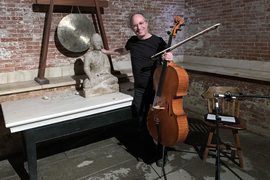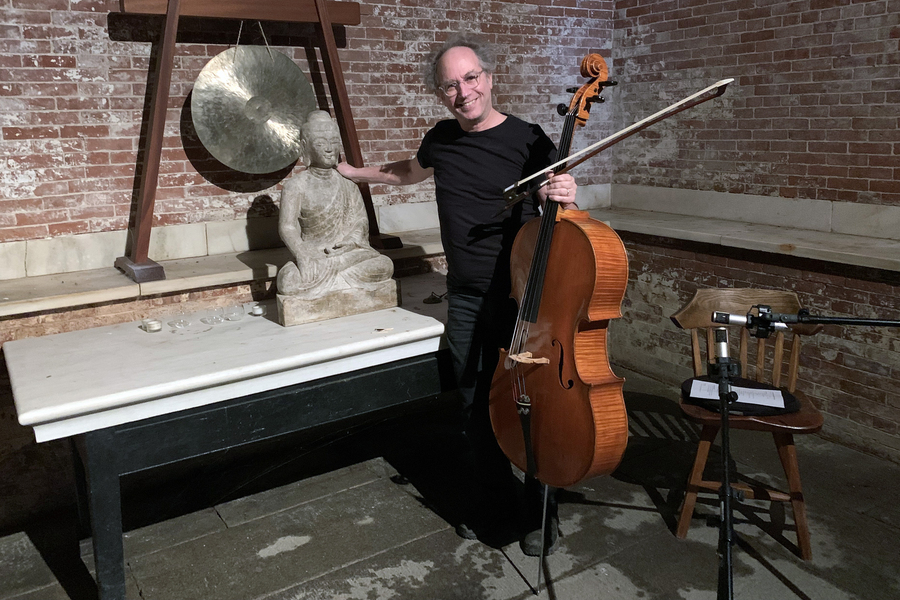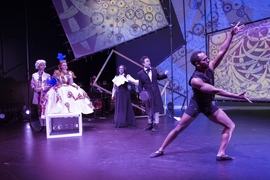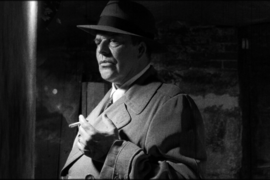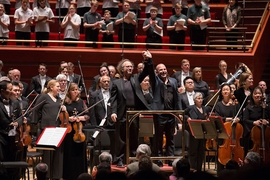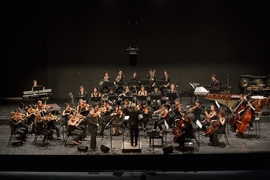Composers find inspiration from many sources. For renowned MIT Media Lab composer Tod Machover, reading the Richard Powers novel “The Overstory” instantly made him want to adapt it as an operatic composition. This might not seem an obvious choice to some: “The Overstory” is about a group of people, including a wrongly maligned scientist, who band together to save a forest from destruction.
But Machover’s resulting work, “Overstory Overture,” a 35-minute piece commissioned and performed by the chamber ensemble Sejong Soloists, has come to fruition and will have its world premiere on March 7 in Alice Tully Hall at New York’s Lincoln Center. Opera superstar Joyce DiDonato will have the lead role, with Earl Lee conducting. On March 16, the piece will have its second performance, in Seoul, South Korea. MIT News recently talked to Machover about his original new work.
Q: How did you get the idea for your new work?
A: I’ve been a fan of Richard Powers’ novels for a long time. He started out as a musician. He’s a cellist like I am, and was a composer before he was a writer, and he’s also been deeply interested in science for his whole career. All of his novels have something to do with people, ideas, music, and science. He’s always been on my radar.
Q: What’s compelling to you about this particular Powers book?
A: “The Overstory” is made up of many stories about characters who come together, improbably, because of trees. It starts with short chapters describing characters with relationships to trees. One is about a family that moved to the Midwest and planted a chestnut tree. It grows for 150 years and they take pictures every year, and it’s at the center of the family until it gets cut down in the 1990s. Another guy is in a plane in Vietnam and gets shot down, and his parachute gets caught in a tree right before he hits the ground.
One character is named Patricia Westerford and she’s a scientist. Her life work is studying the forest and trees, and she discovers that trees communicate — both underground, through the roots, and through the air, via particles. They’re much more like a network than they are static, isolated objects. Her whole world is discovering the miracle of this network, but nobody believes her and she loses her tenure. And she basically goes and lives in the forest. Eventually all the characters in the book come together to preserve a forest in the Northwest that’s going to be destroyed. They become connected through trees, but in the book, all their lives are basically destroyed. It’s not a happy ending, but you understand how human beings are connected through the natural world, and have to think about this connection in a radically new way.
Every single character came alive. The book is just a miracle. It’s a great work of art. Immediately, reading it, I thought, this is something I want to work on.
Q: How did you start turning that into an operatic composition?
A: I got in touch with Powers soon after that. Richard knew my music and answered immediately, saying, “I’d love to have you do an opera on this, and let’s figure out how.” I started working on it just before the pandemic. Around that time he came to Harvard to give a lecture, so he came here to my office in the Media Lab, and we got to chat.
Generally novels leave more room for you to decide how to make music out of them; they’re a lot less scripted than a movie or a play, and the many inner thoughts and asides leave room for music to fill in. I asked Richard, “Would you be interested in writing the text for this?” And right away he said, “Look, I’d like to be involved in the process, but I don’t feel equipped to write a libretto.” So, I went to Simon Robson, who worked on “Schoenberg in Hollywood” [another Machover opera], and we started working and checked in with Richard from time to time.
Just about that time the ensemble Sejong Soloists, who are based in New York and Seoul, offered to have their string orchestra collaborate on a project with a theatrical aspect, which was new for them. I explained I was working on an opera based on “The Overstory,” and I felt we could explore its themes. I could imagine the string instruments being like trees and the orchestra being the forest.
The next thing I did was contact my favorite singer, Joyce DiDonato. She’s such a beautiful, powerful singer. I did an opera in 1999 for Houston called “Resurrection,” which was based on Tolstoy’s last novel, and we were casting the main female character. We did auditions in New York, Los Angeles, and Europe, couldn’t find the main character, and finally the head of the Houston Grand Opera said, “You know, there’s this young singer in our apprentice program who’s pretty special, and you should hear her.”
And sure enough, that was Joyce. It was her first major role. We hadn’t done another project together although we remained close over the years, but I called her and said “Joyce, I know how busy you are, but I’ve got this idea, and I’ll send you the book. It’s great and I’d love to focus on this one character, would you consider doing it?” And she said she’d love to, partly because sustainability and the environment is something she really cares about.
Q: Okay, but how do you get started writing music for a piece when it’s based on a book about trees?
A: I began with two things. Musically I started with the idea of creating this language for tree communication. I was inspired by this idea that one of the reasons we don’t know about it is it’s underground, it’s low, it’s spreading out. I’m a cellist, and I’ve always loved music that grows from the bottom. When you play the cello, in a lot of the great literature, you’re playing the low part of a quartet or quintet or orchestra, and often people don’t quite hear it as the most prominent thing.
The second thing I did was start making this text. Which was hard, because it’s a big novel. It’s a 35-minute piece where Joyce is at the center. When she starts, she just talks, for a minute, and then little by little it turns into song. It’s her sharing with everybody what she learned, she brings you into the world of the forest. In time, there’s a crisis, they’re destroying the forest, and as she says, they’re tearing out the lungs — tearing out the mind — of the world. The last part of the piece is a vision of how the trees need us but we need them even more.
Q: I don’t want to push too hard on this, but the composition sounds parallel with its subject matter. Trees are connected; an orchestra is connected. And then this story is about people building a connection to nature, while you want the audience to feel a connection to the piece. How much did you think about it that way?
A: I was thinking about that pretty consciously, and I really tried to make something that feels very still and simple, but where there’s a lot going on. It feels like it’s living and moving. The piece starts out with solo instruments, so at first everybody’s doing their bit, then they all join in. The strings make a rich ensemble sound, but in the last section every single instrument has its own part — I wrote an individual part for all these string players so they’re kind of weaving in and out. Musically it’s very much constructed to lead people through a forest that is both diverse but connected together.
I also enjoy using electronics to add another dimension. In this piece I’ve tried to create an electronic world that doesn’t necessarily remind you of electronics, except for one part where machines comes in ripping the forest apart. But mostly the electronics are blended with the orchestra in a way you might not always notice. The sound and feel, hopefully, will appear more natural than nature.
Q: You also seem to have clearly identified a story with real operatic drama here, unusual as it may be.
A: The emotional transition that happens is the awareness of what the forest means, and in your gut what it means to protects it, and what it would mean to lose it, and then a glimpse of what it might feel like to live in a different way. I think the contribution someone like myself might be able to make is to change attitudes, to think about our limits as a species and as individuals. Technical solutions alone aren’t going to solve things; people’s behavior somehow has to change. A piece like this is a way of having the experience of crisis, and a vision of what could be different.
Q: Here’s something a lot of us want to know: What’s it like working with Joyce DiDonato?
A: She’s one of those rare people. She’s completely direct and honest and lives life to the fullest. Joyce, I mean, thank God she has the best voice you’ll ever hear and she’s at the top of her game, but she also thinks about the world and ideas, and she did a whole project a few years ago performing a repertoire around the world about war and peace, to jolt people into a new understanding. Every project she’s involved with, she cares about the characters and she’s in it all the way.
For this piece we did a bunch of Zoom sessions and tried things out. And she’s fantastic at saying, “To make that phrase the best you can for my voice at this point in the piece, would you consider changing that one note?” She has incredibly precise ideas about that. So, we worked musically on every detail and on the whole shape. What a pleasure! She also came here to MIT. She hadn’t been to the Media Lab, so she spent two days here at the beginning of August with her partner. She was so open to all the students and all the ideas and inventions and machines and software, just in the most gracious and truly excited way. You couldn’t have had a better visitor.
Q: Any last thoughts about this piece you want to share?
A: In my music in general, I’m pretty voracious at combining different things. I think in this project where it involves the natural world and the language of trees, and the language of melodies and instruments and electronic music, there may be more elements I’ve pulled together than ever. The emotional and even musical world here is larger. That’s my story here: These elements require and invite new thinking. And remember: This is just the first part of a larger project. I hope that you can hear the full “Overstory” opera — perhaps with trees growing in a major opera house — in the not-so-distant future!
